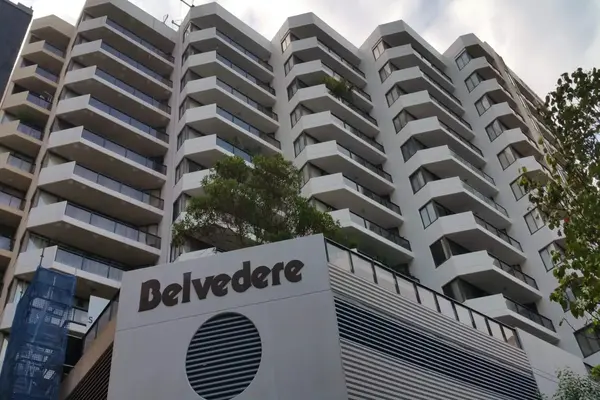Project Remediate is the New South Wales Government program that assesses, designs and delivers the replacement of combustible cladding on occupied residential strata buildings. MJ Engineering Projects (MJEP) contributed to three interconnected scopes: façade-engineering investigation, fire-engineering investigation and superintendent services during construction. The following summarises how our role in Project Remediate guided several Class 2 buildings from early triage through certified completion, keeping residents safe, protecting the owners corporation’s budget and satisfying the program’s tight performance timetable.
Project Background
After the Grenfell Tower disaster in London, combustible aluminium-composite panels were identified on hundreds of New South Wales apartment buildings; the Office of the Building Commissioner launched Project Remediate to help owners fund and coordinate façade replacement. The program manager, Hansen Yuncken, leads a network of auditors, designers, builders and independent assurers. MJEP, with fifteen years of remedial-works experience, joined at three levels:
- Façade engineer during planning and investigation
- Fire engineer during planning and investigation
- Superintendent during remediation construction
Each role carried separate contractual duties, yet all three shared the single aim of delivering a fire-safe, weather-tight façade for every participating building.
Façade Engineer Scope Summary
- Document review and data planning
MJEP began by analysing as-built drawings, council fire orders, maintenance logs and previous condition reports. The Project Remediate team coordinated with the investigation lead to decide which façade zones, panel sizes and fixings should be sampled, ensuring access demands and resident disruption were minimal. - On-site investigation and testing
We examined installation systems, framing, junctions, weatherproofing, combustibility of fixings and adjoining services. Hammer sounding and cover-meter scans assessed structural tolerances, movement joints and wind-load resistance. - Reporting
All findings fed into our comprehensive Investigation Report. The report listed combustible quantities, structural constraints, ancillary defects and recommended replacement options. A project brief summarised façade remediation scope, prepared in the format required by the Cladding Product Safety Panel and pattern book. If requested, MJEP attended review sessions with the client, Fire and Rescue NSW or council officers to answer technical queries.
Fire Engineer Scope Summary
- Fire document review
Fire orders, previous performance solutions and council correspondence were examined alongside façade drawings. MJEP validated any existing fire-engineering reports, noting gaps in data or changed regulations. - Field assessment
On-site inspections checked panel composition, cavity barriers, fixings, compartment separation and proximity to exits. We assessed potential ignition sources and mapped fire-spread scenarios, paying close attention to balcony interfaces, services risers and penetrations. - Risk ranking and mitigation strategy
Buildings were scored for ignition likelihood, consequence and existing fire-safety measures. Where combustible cladding bridged fire compartments, MJEP proposed interim risk-mitigation actions. - Fire-safety reporting and project brief
All observations were consolidated into an Investigation Fire Safety Report, outlining risk level, recommended replacement materials and required temporary measures. The report concluded with a fire-remediation project brief that dovetailed with the façade-engineering brief, providing the design consortium with a unified scope for the next phase.
Superintendent Scope Summary
- Pre-mobilisation duties
We confirmed that the contractor accepted principal-contractor status, reviewed its project-specific WHSE plan through an independent desktop audit and chaired a pre-start meeting with Hansen Yuncken, the independent assurer and design consultants. All site staff completed mandatory TAFE and SafeWork training and uploaded credentials to the SignOnSite platform. - Contract administration and site governance
MJEP issued directions only to contracting parties, responded to RFIs and used Aconex and BIM 360 for document control. Monthly Payapps claims were certified with supporting progress reports, and variation, delay and provisional-sum claims were assessed in consultation with the quantity surveyor. - Quality assurance and critical inspections
We approved the contractor’s quality-management plan, established hold points for critical stage inspections and ensured defects were logged and closed out. Samples, prototypes and shop drawings were reviewed with the design consultant, and any latent conditions were resolved through coordinated design variations lodged under the Design and Building Practitioners Act. - WHSE oversight
Using the Project Remediate Red and Yellow Card system, MJEP reviewed incident reports, verified corrective actions and ensured tamper-proof scaffold locks and child-safe site procedures were in place. - Practical completion and handover
MJEP coordinated final inspections during Project Remediate with the independent assurer, design team and consent authority, verified warranties and operation manuals, and confirmed all Building Compliance Declaration submissions. Practical-completion certificates and remediation-assurance certificates were issued, followed by a post-completion report outlining final cost, time and performance outcomes. The superintendent then monitored the defects-liability period and certified final payments.
Key Challenges and Solutions
Access and safety
Project Remediate included complex façades required drones and mobile EWP units for safe sampling. MJEP’s phased access strategy, approved by the managing contractor.
Budget control
Value-engineering sessions during Project Remediate balanced non-combustible aluminium, steel and fibre-cement options against whole-of-life costs, ensuring strata funds covered both cladding and ancillary water-ingress repairs.
Regulatory compliance
Early alignment with the Cladding Product Safety Panel pattern book and FRNSW storage rules meant no re-work orders were issued, and each project achieved Building Commissioner sign-off at the first submission during Project Remediate.
Conclusion
By integrating façade and fire-engineering investigations with superintendent contract administration, MJ Engineering Projects guided Project Remediate buildings from triage to certified completion. Owners corporations received clear risk assessments, realistic budgets and independent oversight, while residents benefited from safer, compliant façades delivered with minimal disruption. For further case studies on cladding replacement, waterproofing and concrete remediation, visit our blog or contact the remedial works team to discuss upcoming projects.



